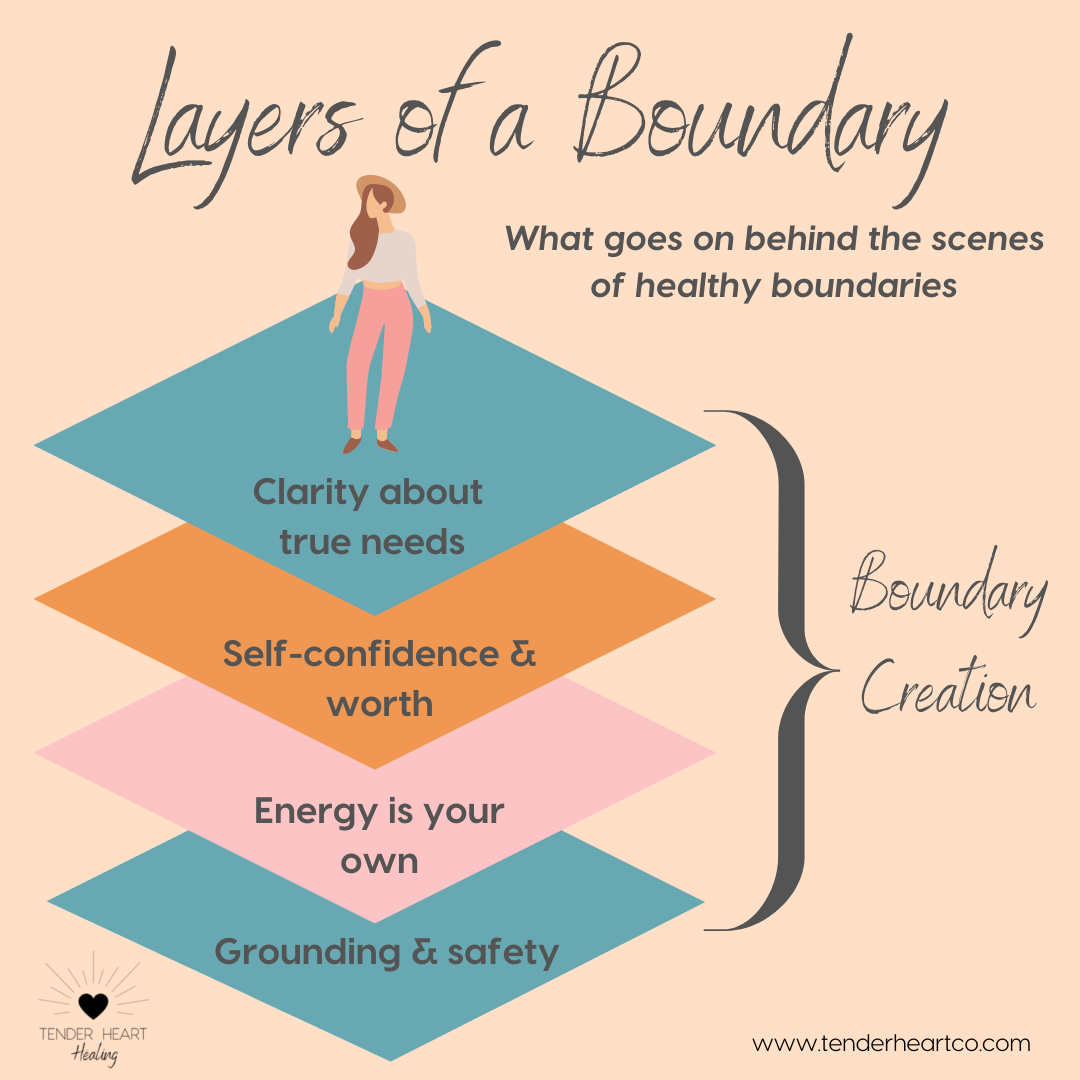Are Your Boundaries Acting Like a Nightclub Bouncer? If not, they should be…
I talk a lot about boundaries in Reiki healing sessions with my clients. I’ve learned over the years of doing energy healing work that boundaries are really the crux of so many issues when it comes to a healthy wellbeing.
I’ve actually written a whole OTHER POST about WHAT boundaries are and WHY they are important, but I’ve realized that it didn’t answer the question of HOW to actually make these boundaries.
As much as we’d like to just draw a line in the proverbial sand and say “this is my boundary”, there are SO many mental, emotional, and spiritual factors that go into creating healthy boundaries. I think the best way to think about creating boundaries is understanding all the layers that support and create space for this type of energetic protection.
Learning the layers or “anatomy” of a boundary is what helps you actually create one. The layers below are also steps to take as you assess which situations or relationships are aligned with your highest good and best self.
1. Grounding and Safety:
Grounding is a whole other post all to itself, but essentially it means you are connected to the earth, your body, and the reality around you. You have a sense of calm and safety within your mental, emotional and spiritual self.
Grounding allows you to be present in the here and now, which allows you to create a solid, safe boundary. If you are “floating”, it’s hard to know where, how, or whom to make boundaries for because you aren’t fully present within yourself.
The analogy of a “floating balloon” is helpful when thinking about boundaries. When you are holding a balloon, you have a say about who touches it, how exposed it is to the elements, and how to keep it safe. If you let go of the balloon and it floats up into the sky, you no longer have control over what affects the balloon. It could go too high, get popped by the sun or another person, get rained on, or send far away by wind.
Your body and energy are similar to the balloon; when you are rooted to the here and now, you have a say in how others treat you, what your true needs are, and how to protect your wellbeing.
2. Energy is Your Own:
Energy clearing is also a something I talk about at length during healing sessions! Separating what is and is not yours is essential to creating healthy boundaries. If you are so intertwined with other people’s traumas, dramas, and emotions, you can’t differentiate what is yours, which makes it impossible to create a boundary to protect your true self.
Photo by Brooke Cagle on Unsplash
If you don’t clear your energy often, you may be making boundary decisions based on other people’s needs and problems. I have been guilty of this in past romantic relationships when I agree to an activity that I know drains me or doesn’t align with what I really need.
I would become so overwhelmed by the other person’s desires and needs that I was unable to speak up and really honor myself. This eventually led to resentment, burnout, and a deeper feeling of unease in my spiritual self.
The concept of clearing energy can be applied to any of our day-to-day life scenarios. We take on other people’s emotional “stuff” from work, family, friends, and typically most obvious, our romantic relationships.
Remember, it’s ok to sympathize, have compassion, and serve those around you. The difference is not to let their needs become your own or block yours completely. Which leads us to the next layer….
3. Self-Confidence and Worth:
Believing you are worthy of boundaries isn’t always an obvious piece to the puzzle. Culturally, we are praised for lacking boundaries (the over-busy, over-tired “warrior”, for example). Putting everyone else first is our culture validating the story that we aren’t deserving of healthy parameters around our time and energy.
Boundaries are can also be compromised when we are overly-concerned with how other people will feel, what they will think, or if we’ve been a “good” mother, sister, son, spouse, etc. To truly create and keep healthy boundaries, we must release the story of “selfishness” when it comes to claiming what we need, and nurture our confidence to remember our inherent value.
We can say we want boundaries or know we need them, but if we don’t actually believe we are worthy of rest, joy, or overall wellbeing, it will be impossible to take the steps to truly implement healthy limits on your time, energy, and effort.
4. Clarity About True Needs:
All of the other layers make this one possible: Understanding your true needs can only happen if you are grounded, clear of other energies, and believe you are worthy of creating boundaries.
Once all of those are in place, you can take a step back and understand what you really need, which brings confidence and clarity to whatever boundary you create. If you attempt to create a boundary around what other people need or think you need, it won’t feel empowering or authentic.
The other part of this layer is releasing any stories about what you think you “should” need, or any limiting beliefs that have kept you from truly honoring yourself.
One of my own beliefs I’ve been working to release is “I need to be productive to be worthy of rest.” (What I’m learning on my personal boundary journey is that I actually need to rest in order to be productive!) You can see how this belief also encompasses worthiness and how I view my time and energy. It’s easy to put pressure on ourselves and blur true needs with obligatory or guilt-centered “shoulds”.
Remember the overall definition of a boundary is declaring what is “ok and not ok” for your wellbeing, energy, and integrity. It is choosing to honor your own wellbeing, which may mean you disappoint others to be true to yourself.
This doesn’t mean you put up firewalls or cut people out of your life, but it does mean you probably won’t say “yes” to everything, which can feel hard if this is your “go-to” habit!
So, when you are thinking about how to create and implement a boundary, look back at this list and see if you are:
· Grounded: Feeling safe, secure, present, and in your body
· Cleared of Other Energies: Releasing things you are holding or absorbing for others
· Aware of your inherent worth: Notice what beliefs you need to release in order to truly honor yourself
· Clear on Your Own Needs: You can’t declare what is “ok and not ok” for you if you don’t know what that is! Tap in and listen to your inner guidance about what your needs really are.
Photo by Peter Conlan on Unsplash
If you feel confident in these different steps, then you’ve already begun to create boundaries in your life. It will become much more obvious when things cross your boundary because you’ve gotten clear on your personal perimeters. Then you have the opportunity to decide if you want to accept it or not, which is the very essence of a boundary!
For more help in creating personal boundaries, you can sign up for Tender Heart Healing’s Meditation Library and listen to my Creating Boundaries Meditation.





